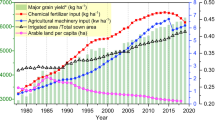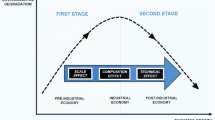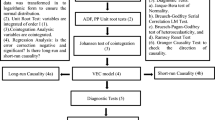Abstract
As the largest contributor to water impairment, agriculture-related pollution has attracted the attention of scientists as well as policy makers, and quantitative information is being sought to focus and advance the policy debate. This study applies the panel unit root, heterogeneous panel cointegration, and panel-based dynamic ordinary least squares to investigate the Environmental Kuznets Curve on environmental issues resulting from use of agricultural synthetic fertilizer, pesticide, and film for 31 provincial economies in mainland China from 1989 to 2009. The empirical results indicate a positive long-run co-integrated relationship between the environmental index and real GDP per capita. This relationship takes on the inverted U-shaped Environmental Kuznets Curve, and the value of the turning point is approximately 10,000–13,000, 85,000–89,000 and over 160,000 CNY, for synthetic fertilizer nitrogen indicator, fertilizer phosphorus indicator and pesticide indicator, respectively. At present, China is subject to tremendous environmental pressure and should assign more importance to special agriculture-related environmental issues.
Similar content being viewed by others
References
Thorburn P J, Biggs J S, Weier K L, Keating B A. Nitrate in groundwaters of intensive agricultural areas in coastal Northeastern Australia. Agriculture, Ecosystems & Environment, 2003, 94(1): 49–58
European Environment Agency (EEA). Source apportionment of nitrogen and phosphorus inputs into the aquatic environment (No.7/2005). Copenhagen: EEA, 2005
Zhang J, Jorgensen S E. Modeling of point and nonpoint nutrient loadings from a watershed. Environmental Modelling & Software, 2005, 20(5): 561–574
Kronvang B, Vagstad N, Behrendt H, Bogestrand J, Larsen S E. Phosphorus losses at the catchment scale within Europe: an overview. Soil Use and Management, 2007, 23(Suppl 1): 104–116
Department for Environment Food and Rural Affairs (DEFRA). Mapping the problem: risks of diffuse water pollution from agriculture. London: DEFRA, 2004
Department for Environment Food and Rural Affairs (DEFRA). Nitrates in water-the current status in England. London: DEFRA, 2007
United States Environmental Protection Agency (USEPA). National water quality inventory. Washington, D C: USEPA. 2009
Chen M, Chen J, Sun F. Estimating nutrient releases from agriculture in China: an extended substance flow analysis framework and a modeling tool. Science of the Total Environment, 2010, 408(21): 5123–5136
Zhang W, Tian Z, Zhang N, Li X. Nitrate pollution of groundwater in northern China. Agriculture, Ecosystems & Environment, 1996, 59(3): 223–231
Liu Y, Chen S, Zhang Y. Study on Chinese agricultural EKC: evidence from fertilizer. Chinese Agricultural Science Bulletin, 2009, 16: 263–267 (in Chinese)
Grossman G, Krueger A B. Environmental impact of North American Free Trade Agreement. NBER Working Paper, No. 3914, 1991
Grossman G, Krueger A B. Economic growth and the environment. Quarterly Journal of Economics, 1995, 110(2): 353–377
Panayotou T. Empirical tests and policy analysis of environmental degradation at different stages of economic development. Working Paper, International Labor Office, Technology and Employment Programme, 1993
Dinda S. Environmental Kuznets Curve hypothesis: a survey. Ecological Economics, 2004, 49(4): 431–455
Brock WA, Taylor M S. Economic growth and the environment: a review of theory and empirics. In: Aghion P, Durlauf S, eds. Amsterdam: Handbook of Economic Growth, 2005, 1(28): 1749–1821
Antler J M, Heidebrink G. Environment and development: theory and international evidence. Economic Development and Cultural Change, 1995, 43(3): 603–625
McConnell K E. Income and the demand for environmental quality. Environment and Development Economics, 1997, 2(4): 383–399
Shortle J S, Abler D. Environmental policies for agricultural pollution control. New York: CAB International Publishing, 2001
Cochard F, Willinger M, Xepapadeas A. Efficiency of nonpoint source pollution instruments: an experimental study. Environmental and Resource Economics, 2005, 30(4): 393–422
Aftab A, Hanley N, Baiocchi G. Integrated regulation of non-point pollution: combining managerial controls and economic instruments under multiple environmental targets. Ecological Economics, 2010, 70(1): 24–33
Managi S. Are there increasing returns to pollution abatement? Empirical analytics of the Environmental Kuznets Curve in pesticides. Ecological Economics, 2006, 58(3): 617–636
Perman R, Stern D I. Evidence from panel unit root and cointegration tests that the Environmental Kuznets Curve does not exist. Australian Journal of Agricultural and Resource Economics, 2003, 47(3): 325–347
Galeotti M, Manera M, Lanza A. On the robustness of robustness checks of the Environmental Kuznets Curve hypothesis. Environmental and Resource Economics, 2009, 42(4): 551–574
Stern D I, Common M S. Is there an Environmental Kuznets Curve for sulfur? Journal of Environmental Economics and Management, 2001, 41(2): 162–178
Oh W, Lee K. Energy consumption and economic growth in Korea: testing the causality relation. Journal of Policy Modeling, 2004, 26(12): 973–981
Copeland B, Taylor S. Trade, growth and the environment. Journal of Economic Literature, 2004, 42(1): 7–71
Unruh G C, Moomaw W R. An alternative analysis of apparent EKC-type transitions. Ecological Economics, 1998, 25(2): 221–229
McCoskey S, Kao C. Comparing panel data cointegration tests with an application of the twin deficits problem. Working Paper, Center for Policy Research, Syracuse University, 1999
McCoskey S, Kao C. A Monte Carlo comparison of tests for cointegration in panel data. Journal of Propagation in Probability and Statistics, 2001, 1(2): 165–198
Mark N, Sul D. Nominal exchange rates and monetary fundamentals: evidence from a small Post-Bretton woods panel. Journal of International Economics, 2001, 53(1): 29–52
Andreoni J, Levinson A. The simple analytics of the Environmental Kuznets Curve. Journal of Public Economics, 2001, 80(2): 269–286
Stokey N L. Are there limits to growth? International Economic Review, 1998, 39(1): 1–31
Jones L E, Manuelli R E. Endogenous policy choice: the case of pollution and growth. Review of Economic Dynamics, 2001, 4(2): 369–405
Israel D, Levinson A. Willingness to pay for environmental quality: testable empirical implications of the growth and environment literature. Contributions to Economic Analysis and Policy. Berkeley: Berkeley Electronic Press, 2004
Stern D I. The Environmental Kuznets Curve. International Society for Ecological Economics, Internet Encyclopedia of Ecological Economics, 2003
Stern D I. Between estimates of the emissions-income elasticity. Ecological Economics, 2010, 69(11): 2173–2182
Wang S, Peng E, Wu G, Zhang T, Zhang J, Zhang C, Yu Y. Surveys of deposition and distribution pattern of pesticide droplets on crop leaves. Journal of Yunnan Agricultural University, 2010, 25(1): 113–117
Yuan P. Environmental economics study on agricultural pollution and its control. Dissertation for the Doctoral Degree, Beijing: Chinese Academy of Agricultural Sciences, 2008 (in Chinese)
Engle R F, Granger C W J. Cointegration and error correction: representation, estimation, and testing. Econometrica, 1987, 55(2): 251–276
Ozturk I, Aslan A, Kalyoncu H. Energy consumption and economic growth relationship: Evidence from panel data for low and middle income countries. Energy Policy, 2010, 38(8): 4422–4428
Pedroni P. Critical values for cointegration tests in heterogeneous panels with multiple regressors. Oxford Bulletin of Economics and Statistics, 1999, 61(S1): 653–670
Li F, Dong S. L X, Liang Q, Yang W. Energy Consumption-Economic Growth Relationship and Carbon Dioxide Emissions in China. Energy Policy, 2011, 39(2): 568–573
López-Pueyo C, Barcenilla-Visús S, Sanaú J, International R. D spillovers and manufacturing productivity: a panel data analysis. Structural Change and Economic Dynamics, 2008, 19(2): 152–172
Levin A, Lin C, Chu C. Unit root tests in panel data: asymptotic and finite-sample properties. Journal of Econometrics, 2002, 108(1): 1–24
Im K S, Pesaran M H, Shin Y. Testing for unit roots in heterogeneous panels. Journal of Econometrics, 2003, 115(1): 53–74
Maddala G S, Wu S. Comparative study of unit root tests with panel data and a new simple test. Oxford Bulletin of Economics and Statistics, 1999, 61(s1): 631–652
Choi I. Unit root tests for panel data. Journal of International Money and Finance, 2001, 20(2): 249–272
Pedroni P. Panel cointegration: asymptotic and finite sample properties of pooled time series tests, with an application to the PPP hypothesis: new results. Working Paper in Economics, Indiana University, 1997
Pedroni P. Panel cointegration: asymptotic and finite sample properties of pooled time series tests with an application to the PPP hypothesis. Economic Theory, 2004, 20: 597–625
Phillips P C B, Moon H R. Linear regression limits theory for nonstationary panel data. Econometrica, 1999, 67(5): 1057–1111
Pedroni P. Fully modified OLS for heterogeneous cointegrated panels. In: Baltagi B H, ed. Advances in Econometrics. Nonstationary Panels, Panel Cointegration and Dynamic Panels. Amsterdam: JAI Press, 2000
Kao C, Chiang M H. On the estimation and inference of a cointegrated regression in panel data. In: Baltagi B H, ed. Advances in Econometrics. Nonstationary Panels, Panel Cointegration and Dynamic Panels. Amsterdam: JAI Press, 2000
Arrow K, Bolin B, Costanza R, Dasgupta P, Folke C, Holling C S, Jansson B O, Levin S, Mäler K G, Perrings C, Pimentel D. Economic growth, carrying capacity, and the environment. Science, 1995, 268(5210): 520–521
Cole M A, Rayner A J, Bates J M. The Environmental Kuznets Curve: an empirical analysis. Environment and Development Economics, 1997, 2(4): 401–416
Park S, Lee Y. Regional model of EKC for air pollution: Evidence from the Republic of Korea. Energy Policy, 2011, 39(10): 5840–5849
de Bruyn S M, van den Bergh J C J M, Opschoor J B. Economic growth and emissions: reconsidering the empirical basis of Environmental Kuznets Curves. Ecological Economics, 1998, 25(2): 161–175
Markus P. Technical progress, structural change and the Environmental Kuznets Curve. Ecological Economics, 2002, 2(3): 381–389
Roca J, Padilla E, Farre M, Galletto V. Economic growth and atmospheric pollution in Spain: discussing the Environmental Kuznets Curve hypothesis. Ecological Economics, 2001, 39(1): 85–99
Magnani E. The Environmental Kuznets Curve: development path or policy results. Environmental Modelling & Software, 2001, 16(2): 157–165
Orubu C O, Omotor D G. Environmental quality and economic growth: Searching for Environmental Kuznets Curves for air and water pollutants in Africa. Energy Policy, 2011, 39(7): 4178–4188
Author information
Authors and Affiliations
Corresponding author
Rights and permissions
About this article
Cite this article
Li, F., Dong, S., Li, F. et al. Is there an inverted U-shaped curve? Empirical analysis of the Environmental Kuznets Curve in agrochemicals. Front. Environ. Sci. Eng. 10, 276–287 (2016). https://doi.org/10.1007/s11783-014-0700-y
Received:
Accepted:
Published:
Issue Date:
DOI: https://doi.org/10.1007/s11783-014-0700-y




